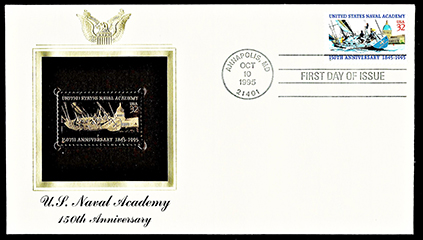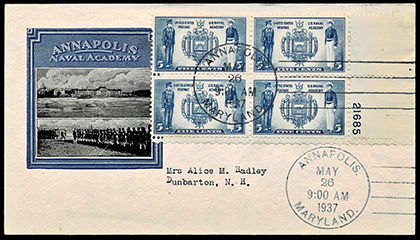
Maryland on Stamps…


Naval Academy,1937/1995
Richard D. L. Fulton
You may fire when you are ready, Gridley. — Naval Academy Admiral George Dewey, Opening of the Battle of Manila Bay, 1898.
On May 16, 1937, the United States Postal Service (USPS) issued a five-cent stamp commemorating the establishment of the United States Naval Academy (USNA) at Annapolis. The stamp featured two midshipmen standing at attention, flanking the academy’s official seal. The first-day-of-issue stamps were postmarked at the Annapolis Post Office.
On October 10, 1995, the USPS issued a 32-cent stamp commemorating the 150th Anniversary of the academy, featuring an academy racing sloop (the 44-foot sloop named the Swift) with the academy chapel seen in the background. As per the 1937 stamp, these stamps were also postmarked in Annapolis.
Today, the Naval Academy has 20 sloops, 16 for training and four for racing, according to the USPS.
The Naval Academy was officially established on October 10, 1845, through the efforts of then Secretary of the Navy, George Bancroft, and was officially designated as the Naval School, an act he was able to achieve without requiring any congressional funding.
The school was established at the 10-acre Army Fort Severn, in Annapolis. According to the Naval Academy website, Bancroft selected Annapolis as the official home of the Naval School in order to deprive enrollees of “the temptations and distractions that necessarily connect with a large and populous city.”
There were several previous naval schools, including the Philadelphia Naval Asylum School and schools in New York City, Norfolk, and Boston. President John Quincy Adams had initially urged Congress to establish a naval academy in 1825, but his vision for one would not materialize until 20 years later.
Another precursor of the Annapolis USNA occurred in the form of the first naval training ship established on the American brig Somers in 1842. The “experiment” was rather short-lived, and ended in a mutiny, for which three of the instigators were hung from the ship’s yardarm (a timber spar/beam located on a mast from which the sails are set).
The first class enrolled at the Navy School (which became the Naval Academy in 1850) consisted of 50 midshipmen and seven professors, and included such courses as mathematics, navigation, gunnery, steam (powered engines), chemistry, English, natural philosophy, and French, according to the USNA.
Also in 1850, midshipmen (students) attended for four years, in addition to training aboard ships during the summers, and the academy grew from its original 10 acres to 338 acres in size, and the class grew from 50 midshipmen to 4,000, according to the USNA. Today, the enrollment numbers are around 4,500 students.
In 1933, Congress authorized the academy to award Bachelor of Science degrees. Today, graduates also receive commissions as ensigns in the Navy, or as second lieutenants in the Marine Corps.
There have been, and continue to be, many noteworthy graduates from the Naval Academy. Among the array, one noteworthy historic standout was Geroge Dewey, who became the only Naval Academy graduate to have achieved the rank of admiral. Dewey is best known for his command, under the rank of commodore, of the United States naval forces during the Spanish-American War, when his fleet engaged that of the Spanish in Manila Bay, Philippines, on May 1, 1898.
When Dewey’s fleet came within range of the Spanish, Dewey ordered the flagship’s captain, Charles Vernon Gridley, to open up on the enemy, with the famous command, “You may fire when you are ready, Gridley.”
By the end of the engagement, the Spanish fleet had sustained 167 men killed, and 214 wounded. Dewy’s fleet suffered only seven wounded.
The following year, Dewey was promoted to admiral, thus becoming the only USNA graduate to have held that rank.
